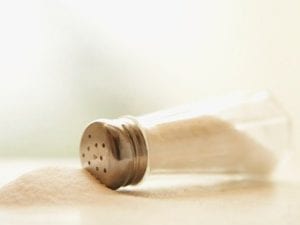 Table salt has been linked to hypertension (high blood pressure), but there may be another side to salt that can make it more ominous for those who either are or may become diabetic.
Table salt has been linked to hypertension (high blood pressure), but there may be another side to salt that can make it more ominous for those who either are or may become diabetic.
The reason this is a concern is based on the link of diabetes and obesity. Salt apparently plays a role in both hypertension and weight gain.
In a recent interview with HealthCastle.com Registered Dietitian and author Tammy Lakatos Shames provides some interesting connections with salt, “We used to always blame carbs or sugar or often whatever else it may be. And sure, these are partially responsible, but now we know that salt is playing a key role as well. First of all, salt makes us both hungrier and thirstier. But an interesting thing that most people don’t know that research shows that it actually makes your fat cells fatter.”
Salt is often used as a taste enhancer that can be used in self proclaimed moderation, but Shames indicates, “Most people don’t think they have a salt problem and the truth of the matter is, a large percentage of us are actually getting two to three times the salt that we actually should. So the bottom line is most of us do have a salt problem.”
Consumers may attempt to do the right thing by purchasing low sodium products and resisting the urge to put too much salt on our foods, but Shames says there may really only be one way to ensure a low salt diet, “Stick to really wholesome foods like fruits and vegetables, whole grains and beans. You have to keep in mind that even foods like bread contain a lot of salt.”
If you’re curious as to the most probable food offenders when it comes to salt Shames says, “Most of us know about the pickled foods but really it’s also those bacon, sausages, the processed meats are really high. Canned foods, processed foods too. Unfortunately, anytime you go to a restaurant or fast food restaurant, usually there is a lot of salt in there as well.”
Shames suggests that humans aren’t born with a taste for salt. This is acquired through diet, “Cut back the salt for about three weeks (21 days), your taste buds like other cells in your body turn over. So that salt that you used to really like, you no longer will like so much. In fact, we have seen this with clients of time and time again where they have salty foods and then they cut back on the salty foods. Then go back to adding salt back in their diet, and suddenly they can’t stand the salt and think that everything tastes too salty.”
Not surprisingly Shames points to processed foods as a primary culprit for excess dietary salt. When cooking fresh meat try adding spices instead of salt and work through small steps to eliminate one source of processed food each day, “Read the label. If you see a snack food that has 400 mg of sodium per serving, you know that it’s going to be too much when you should only be getting a maximum of 2300 mg of sodium a day,” said Shames.
Shames is the author of “The Secret to Skinny” in which she deals extensively with salt in our diets and effective ways to reduce its instance at both mealtimes and snacks.